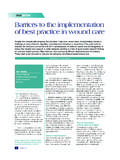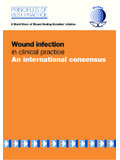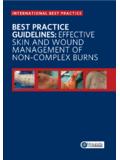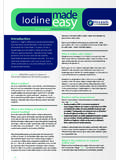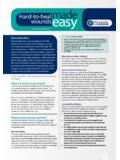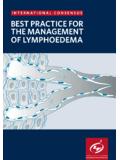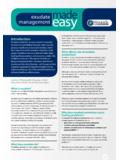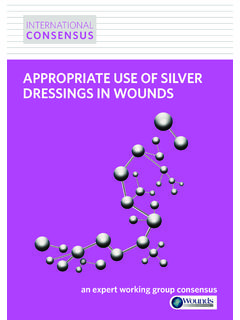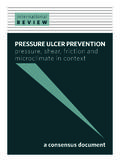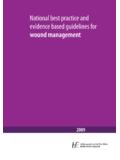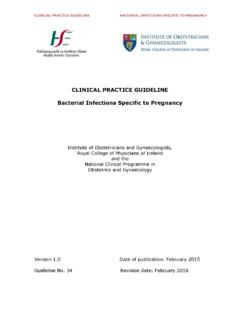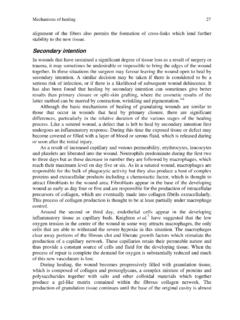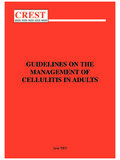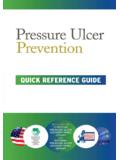Transcription of Clinical PRACTICE DEVELOPMENT Wound bed …
1 Clinical PRACTICE DEVELOPMENT . Wound bed preparation: TIME in PRACTICE Wound bed preparation is now a well established concept and the TIME framework has been developed as a practical tool to assist practitioners when assessing and managing patients with wounds. It is important, however, to remember to assess the whole patient; the Wound bed preparation care cycle' promotes the treatment of the whole' patient and not just the hole' in the patient. This paper discusses the implementation of the Wound bed preparation care cycle and the TIME framework, with a detailed focus on Tissue, Infection, Moisture and Wound Edge (TIME). Caroline Dowsett, Heather Newton dependent on one another.
2 Acute et al, 2003). Wound bed preparation wounds usually follow a well-de ned as a concept allows the clinician to KEY WORDS process described as: focus systematically on all of the critical Wound bed preparation 8 Coagulation components of a non-healing Wound to Tissue 8In ammation identify the cause of the problem, and Infection 8 Cell proliferation and repair of implement a care programme so as to Moisture the matrix achieve a stable Wound that has healthy 8 Epithelialisation and remodelling of granulation tissue and a well vascularised Edge scar tissue. Wound bed. In the past this model of healing has The TIME framework been applied to chronic wounds, but To assist with implementing the T.
3 He concept of Wound bed it is now known that chronic Wound concept of Wound bed preparation, the preparation has gained healing is different from acute Wound TIME acronym was developed in 2002. international recognition healing. Chronic wounds become stuck' by a group of Wound care experts, as a framework that can provide in the in ammatory and proliferative as a practical guide for use when a structured approach to Wound stages of healing (Ennis and Menses, managing patients with wounds (Schultz management. By de nition Wound 2000) which delays closure. The et al, 2003). The TIME table (Table 1). bed preparation is the management epidermis fails to migrate at the Wound summarises the four main components of a Wound in order to accelerate margins, which interferes with normal of Wound bed preparation: endogenous healing or to facilitate cellular migration over the Wound bed 8 Tissue management the effectiveness of other therapeutic (Schultz et al, 2003).
4 8 Control of infection and measures' (Falanga, 2000; Schultz et in ammation al, 2003). The concept focuses the In chronic wounds there appears 8 Moisture imbalance clinician on optimising conditions at to be an over production of matrix 8 Advancement of the epithelial edge the Wound bed so as to encourage molecules resulting from underlying of the Wound . normal endogenous healing. It is an cellular dysfunction and disregulation approach that should be considered for (Falanga, 2000). Fibrinogen and brin The TIME framework is a useful all wounds that are not progressing to are also common in chronic wounds practical tool based on identifying the normal Wound healing.
5 And it is thought that these and other barriers to healing and implementing a macromolecules scavenge growth plan of care to remove these barriers Wound healing is a complex series factors and other molecules involved and promote Wound healing. of events that are interlinked and in promoting Wound repair (Falanga, 2000). Chronic Wound uid is also It is important to understand Wound Caroline Dowsett is Nurse Consultant in Tissue Viability, biochemically distinct from acute Wound bed preparation and TIME within the Newham Primary Care Trust, London, and Heather Newton uid; it slows down, and can block the context of total patient care. If a Wound is Nurse Consultant in Tissue Viability, Royal Cornwall proliferation of cells, which are essential fails to heal there is often a complex Hospital Trust, Cornwall for the Wound healing process (Schultz mix of local and host factors which 58 Wounds UK.)
6 58 2 20/10/05 8:35:35 pm Clinical PRACTICE DEVELOPMENT . Table 1. TIME Principles of Wound bed preparation Clinical observations Proposed pathophysiology WBP Clinical actions Effect of WBP actions Clinical outcome Tissue non-viable or de cient Defective matrix and cell Debridement (episodic or Restoration of Wound base Viable Wound base debris impair healing continuous): and functional extracellular 8 Autolytic, sharp surgical, matrix proteins enzymatic, mechanical or biological 8 Biological agents Infection or In ammation High bacterial counts or Remove infected foci Low bacterial counts or Bacterial balance and prolonged in ammation Topical/systemic: controlled in ammation.
7 Reduced in ammation In ammatory cytokines 8 Antimicrobials In ammatory cytokines Protease activity 8 Anti-in ammatories Protease activity Growth factor activity 8 Protease inhibition Growth factor activity Moisture imbalance Desiccation slows epithelial Apply moisture-balancing Restored epithelial cell Moisture balance cell migration dressings migration, desiccation avoided Excessive uid causes Compression, negative Oedema, excessive uid maceration of Wound margin pressure or other methods controlled, maceration of removing uid avoided Edge of Wound Non-migrating keratinocytes Re-assess cause or consider Migrating keratinocytes Advancing edge of Wound non-advancing or Non-responsive Wound cells corrective therapies: and responsive Wound cells.
8 Undermining and abnormalities in extra- 8 Debridement Restoration of appropriate cellular matrix or abnormal 8 Skin grafts protease pro le protease activity 8 Biological agents 8 Adjunctive therapies will need to be assessed and treated. treatments. Assessment and treatment The TIME table has been designed A full and detailed patient assessment of the underlying condition is essential to help the clinician make a systematic will highlight the underlying aetiology as the type of Wound bed preparation interpretation of the observable of the Wound and other factors that implemented may vary with Wound characteristics of a Wound and to may impede Wound healing such as type.
9 For example, sharp debridement decide on the most appropriate pain and poor nutrition (Dealey, 2000). is common in the management of intervention: With this in mind the Wound bed patients with diabetic foot ulceration, preparation care cycle' was developed while compression therapy is the T for tissue: non-viable or de cient in 2004 (Dowsett, 2004) to provide recommended treatment for patients I for infection/in ammation a care programme that includes the with venous leg ulcers (European M for moisture imbalance TIME framework. It focuses both on Wound Management Association, E for edge, which is not advancing the patient and on the Wound in an 2004).
10 The cycle moves from patient or undermining. attempt to address all factors that assessment and diagnosis to assessing in uence Wound healing. and treating the Wound using the T Tissue TIME framework. The importance The speci c characteristics of the Wound bed preparation care cycle of assessment in terms of evaluating tissue within a Wound bed play a very The care cycle (Figure 1) starts with the effectiveness of the treatment is important role in the Wound healing the patient and their environment of highlighted in the cycle. Those patients continuum. Accurate description of this care. Individual patient concerns need who have healed come out of the cycle tissue is an important feature of Wound to be addressed as well as quality of life into a prevention programme' and assessment.
